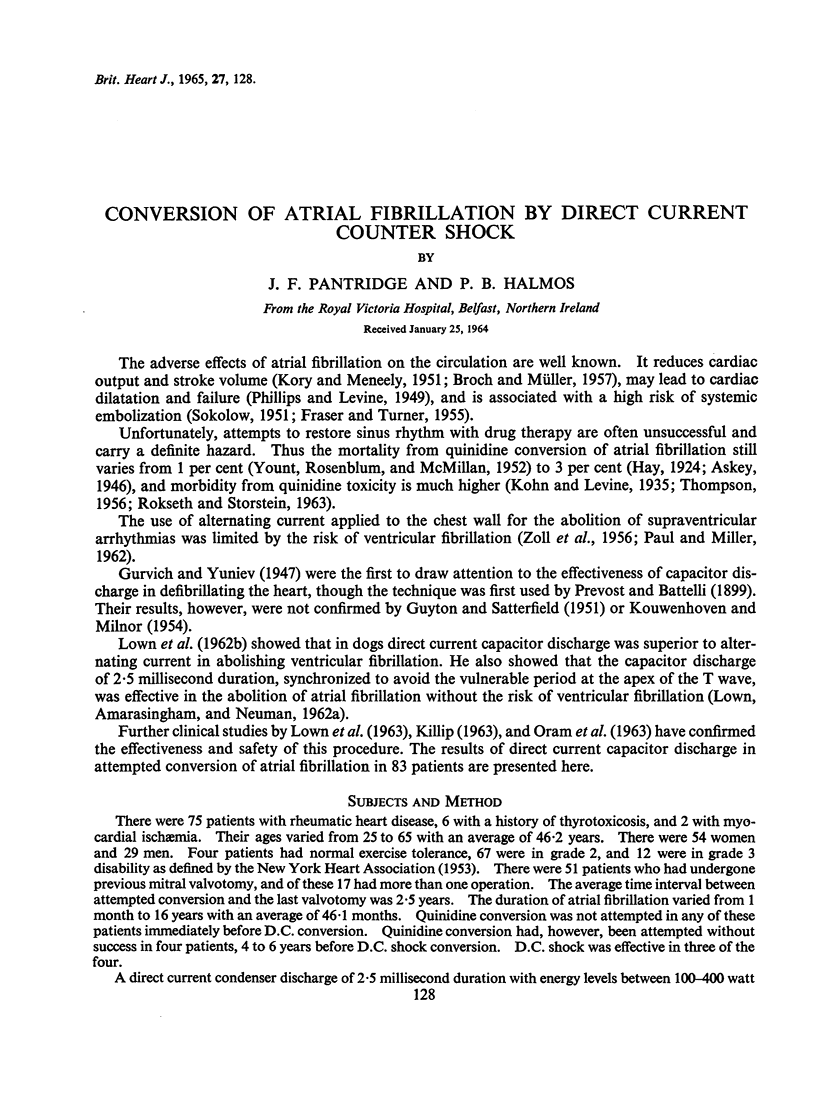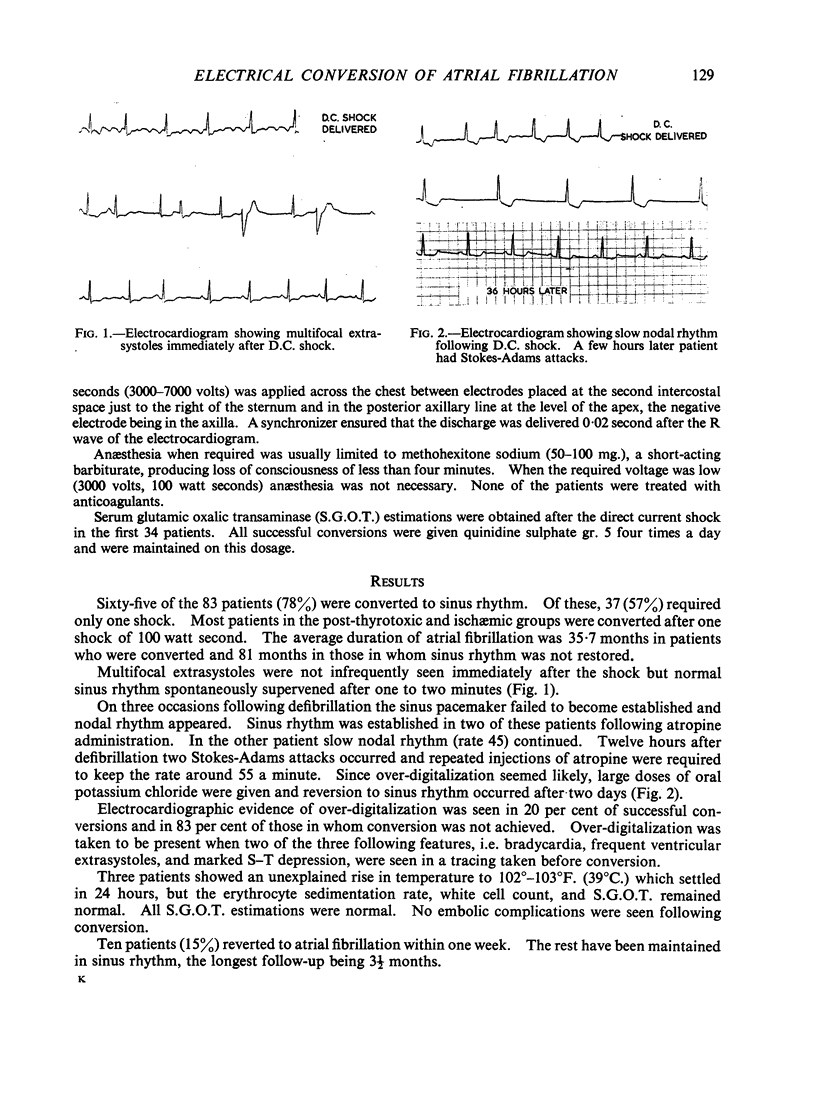Full text
PDF



Images in this article
Selected References
These references are in PubMed. This may not be the complete list of references from this article.
- BROCH O. J., MULLER O. Haemodynamic studies during auricular fibrillation and after restoration of sinus rhythm. Br Heart J. 1957 Apr;19(2):222–226. doi: 10.1136/hrt.19.2.222. [DOI] [PMC free article] [PubMed] [Google Scholar]
- FRASER H. R., TURNER R. W. Auricular fibrillation; with special reference to rheumatic heart disease. Br Med J. 1955 Dec 10;2(4953):1414–1418. doi: 10.1136/bmj.2.4953.1414. [DOI] [PMC free article] [PubMed] [Google Scholar]
- GIBSON W., LINENTHAL A. J., NORMAN L. R., PAUL M. H., ZOLL P. M. The effect of external electric currents on the heart; control of cardiac rhythm and induction and termination of cardiac arrhythmias. Circulation. 1956 Nov;14(5):745–756. doi: 10.1161/01.cir.14.5.745. [DOI] [PubMed] [Google Scholar]
- GUYTON A. C., SATTERFIELD J. Factors concerned in electrical defibrillation of the heart, particularly through the unopened chest. Am J Physiol. 1951 Oct;167(1):81–87. doi: 10.1152/ajplegacy.1951.167.1.81. [DOI] [PubMed] [Google Scholar]
- KILLIP T. SYNCHRONIZED DC PRECORDIAL SHOCK FOR ARRHYTHMIAS. SAFE NEW TECHNIQUE TO ESTABLISH NORMAL RHYTHM MAY BE UTILIZED ON AN ELECTIVE OR AN EMERGENCY BASIS. JAMA. 1963 Oct 5;186:1–7. doi: 10.1001/jama.1963.03710010035004. [DOI] [PubMed] [Google Scholar]
- KOUWENHOVEN W. B., MILNOR W. R. Treatment of ventricular fibrillation using a capacitor discharge. J Appl Physiol. 1954 Nov;7(3):253–257. doi: 10.1152/jappl.1954.7.3.253. [DOI] [PubMed] [Google Scholar]
- LOWN B., AMARASINGHAM R., NEUMAN J. New method for terminating cardiac arrhythmias. Use of synchronized capacitor discharge. JAMA. 1962 Nov 3;182:548–555. [PubMed] [Google Scholar]
- LOWN B., NEUMAN J., AMARASINGHAM R., BERKOVITS B. V. Comparison of alternating current with direct electroshock across the closed chest. Am J Cardiol. 1962 Aug;10:223–233. doi: 10.1016/0002-9149(62)90299-0. [DOI] [PubMed] [Google Scholar]
- LOWN B., PERLROTH M. G., KAIDBEY S., ABE T., HARKEN D. E. "Cardioversion" of atrial fibrillation. A report on the treatment of 65 episodes in 50 patients. N Engl J Med. 1963 Aug 15;269:325–331. doi: 10.1056/NEJM196308152690701. [DOI] [PubMed] [Google Scholar]
- ORAM S., DAVIES J. P., WEINBREN I., TAGGART P., KITCHEN L. D. Conversion of atrial fibrillation to sinus rhythm by direct-current shock. Lancet. 1963 Jul 27;2(7300):159–162. doi: 10.1016/s0140-6736(63)92799-5. [DOI] [PubMed] [Google Scholar]
- PAUL M. H., MILLER R. A. External electrical termination of supraventricular arrhythmias in congenital heart disease. Circulation. 1962 Apr;25:604–609. doi: 10.1161/01.cir.25.4.604. [DOI] [PubMed] [Google Scholar]
- ROKSETH R., STORSTEIN O. Quinidine therapy of chronic auricular fibrillation. The occurrence and mechanism of syncope. Arch Intern Med. 1963 Feb;111:184–189. doi: 10.1001/archinte.1963.03620260044008. [DOI] [PubMed] [Google Scholar]
- SOKOLOW M. The present status of therapy of the cardiac arrhythmias with quinidine. Am Heart J. 1951 Nov;42(5):771–797. doi: 10.1016/0002-8703(51)90184-6. [DOI] [PubMed] [Google Scholar]
- THOMSON G. W. Quinidine as a cause of sudden death. Circulation. 1956 Nov;14(5):757–765. doi: 10.1161/01.cir.14.5.757. [DOI] [PubMed] [Google Scholar]
- YOUNT E. H., ROSENBLUM M., McMILLAN R. L. Use of quinidine in treatment of chronic auricular fibrillation; results obtained in a series of one hundred fifty-five patients. AMA Arch Intern Med. 1952 Jan;89(1):63–69. doi: 10.1001/archinte.1952.00240010073006. [DOI] [PubMed] [Google Scholar]




